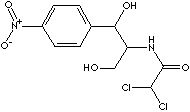| CAS
NO. |
56-75-7 |

|
| EINECS
NO. |
200-287-4 |
| FORMULA |
C11H12Cl2N2O5 |
| MOL
WT. |
323.13 |
|
H.S.
CODE
|
|
|
TOXICITY
|
|
| SYNONYMS |
Chloromycetin;
|
(-)-threo-2,2-Dichloro-N-[beta-hydroxy-alpha-(hydroxymethyl)-beta-
(4-nitrophenyl)ethyl] acetamide; D-threo-N-(1,1'-dihydroxy-1-p-nitrophenylisopropyl)
dichloroacetamide; D-(-)-threo-1-(p-nitrophenyl)-
2-dichloroacetamido- 1,3-propanediol; 2,2-Dichloro-N-[2-hydroxy-1-(hydroxymethyl)-2-(4-nitrophenyl)ethyl]
acetamide; D-(-)-threo- 2,2-Dichloro-N-[beta-hydroxy-alpha-
(hydroxy-methyl)-p- nitrophenethyl] acetamide;
D-threo-N-(1,1'-dihydroxy-1-p-nitrophenylisopropyl) dichloroacetamide;
|
| SMILES |
|
|
CLASSIFICATION
|
|
|
PHYSICAL
AND CHEMICAL PROPERTIES
|
| PHYSICAL
STATE |
white to off-white crystalline
powder |
| MELTING
POINT |
148
- 150 C |
| BOILING
POINT |
|
| SPECIFIC
GRAVITY |
|
| SOLUBILITY
IN WATER |
Slightly soluble |
| pH |
|
| VAPOR
DENSITY |
|
|
REFRACTIVE
INDEX
|
|
|
NFPA
RATINGS
|
|
|
AUTOIGNITION
|
|
| FLASH
POINT |
|
| STABILITY |
Stable
under ordinary conditions. |
|
GENERAL
DESCRIPTION & APPLICATIONS
|
Chloramphenicol is
a relatively simple structure broad-spectrum antibiotic which
is effective against rickettsiae,
gram-positive and gram-negative bacteria, and certain spirochetes by inhibiting
translation on the 50S ribosomal subunit at the peptidyltransferase step
(elongation inhibition). It was originally isolated from a species of
streptomyces bacteria and other spirochetes later, but is produced
synthetically. Because of its toxicity and side-effect, it should only be used
for serious infections in which other medicines do not work; should not be used
for colds, flu, other virus infections, sore throats or other minor infections,
or to prevent infections. It is used especially in the treatment of typhus and
other rickettsial infections and in typhoid, shigellosis, and related enteric
diseases. Chloramphenicol is used in biological research of protein synthesis.
It is a greenish white or yellowish white needle-like solid; slightly soluble in
water and ether; soluble in alcohol; melting point 148-150 C. Its chemical
designation is
D(-)-threo-2,2-Dichloro-N-[beta-hydroxy-alpha-(hydroxymethyl)- beta-(4-nitrophenyl)ethyl]
acetamide
or D-(-)-threo-1-(p-nitrophenyl)-2-dichloro acetamido-1,3-propanediol.
- Chloramphenicol palmitate: the palmitic ester of
chloramphenicol, administered orally.
Chloramphenicol sodium succinate: the
sodium succinate derivative of chloramphenicol, administered
intravenously.
Thiamphenicol:
a methylsulfonyl analog of chloramphenicol
Florfenicol:
a fluorinated analog of thiamphenicol
|
| SALES
SPECIFICATION |
|
APPEARANCE
|
white to off-white crystalline
powder |
|
IDENTIFICATION
|
Complies
|
|
ASSAY
|
99.0
- 101.0%
|
|
OPTICAL
ROTATION
|
+19°
(C=4.9 in EtOH)
|
|
HEAVY
METALS
|
20ppm
max
|
|
SULFATED
ASH
|
0.1%
max
|
|
LOSS
ON DRYING
|
0.5%
max
|
|
CHLORIDE
|
0.1%
max
|
| TRANSPORTATION |
| PACKING |
|
| HAZARD
CLASS |
|
| UN
NO. |
1851 |
| OTHER
INFORMATION |
Hazard Symbols: T, Risk Phrases: 45-42/43, Safety Phrases: 53-36/37-45
Other CAS
RN: 137731-90-9; 15313-32-3; 55172-72-0; 59112-59-3;
85666-84-8 |
|
PRICES |
|

|
